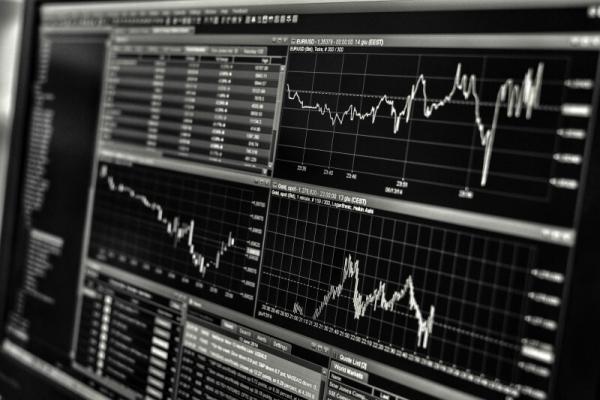

What is Day Trading?
Day trading has grown in popularity since the Internet gave more people access to markets, and technology development has put advanced trading platforms and tools in the hands of retail traders.
Before these developments, the ability to trade actively on a short-term basis was only available to those working for large trading firms and on trading floors. However, day trading is now possible for anyone with an internet connection, a reasonably good computer and money you are willing to risk.
In this guide to day trading, we look at what it is, what it entails, the pros and cons and some of the best day trading strategies to use.
Day Trading Definition
Day trading is the buying and selling of securities in positions almost always opened and closed on the same day. All liquid markets can be day traded, including forex, stocks, commodities, index futures and other derivatives.
How to Day Trade
Day traders use charts and sentiment to generate trading ideas rather than fundamental data. Some specialise in trading a regular list of very liquid instruments like index futures or CFDs and forex pairs. Others trade stocks, looking for the most active and volatile ones each day.
There are several approaches to day trading, but nearly all professional traders follow a disciplined process to find and execute trades each day. This includes research before the market opens and after it closes, building a watch list and developing new strategies.
A trading strategy should include some if not all of the following elements:
- Filter. It's important to only trade a particular strategy when the right market conditions are in place. A filter is a set of rules that may relate to volume, volatility, time of day, and certain indicators' position, which tells you when to begin looking for setups.
- A setup is the second set of rules and conditions that must occur before a trade is entered. When all of these conditions are in place, you'll be looking for a trigger.
- The trigger defines the exact moment you'll enter a trade. This is the last event that needs to occur to confirm a trade. A trigger will often involve the price or an indicator crossing a specific level and closing above or below that level.
- Position size. For each strategy, there should be a specific way to calculate the trade size you'll enter.
- An initial stop loss is a price level where you'll close a losing trade to avoid further losses. By knowing your position's size and the Stop-Loss level before you enter a trade, you'll know your maximum risk for the trade.
- A price target is a level at which you'll close or partially close a trade. This will usually be the price level with the highest probability of reaching and generating a profit.
- A trade management plan includes techniques like trailing stops, scaling, and when you'll close an open position before the market closes.
Day traders must also consistently monitor their performance to build on their strengths and work on weaknesses.
Characteristics of a Day Trader
Day trading effectively requires certain personality traits. It needs to be treated as a serious business rather than a hobby.
- Discipline is possibly the most important trait and applies to several aspects of a trader's routine. Firstly, you will need the discipline to do the necessary preparation before the market opens and after the market closes. You will also need the discipline to live a healthy life and get enough exercise and sleep. Day traders need to be functioning at their best every day, and this requires the right lifestyle.
Discipline is also required to stick with a trading plan, cut losing trades when a stop loss is breached, and hold onto winning trades when that's what the strategy requires. You will also need the discipline to avoid impulse trades or taking excessive risks.
- The ability to focus for long periods of time is also a required trait for day traders. Day traders need to watch charts and watch lists for most of the day, which is not something everyone can do. Day trading is suited to those who can focus and think on their feet. If you aren't able to focus all day, there are other types of trading like swing trading, position trading and trend following that you may be better suited to.
- Patience is required to wait for profitable trading opportunities rather than chasing every stock that seems to be moving. Unlike most careers, with trading, doing more work doesn't necessarily lead to more profits. Sometimes the hard work is the waiting, and that requires patience.
- Curiosity is often overlooked but is essential if you are going to find and maintain a trading edge. Traders who succeed over the long term are those who find new patterns before other traders do. This requires a genuine interest in the market and in trading psychology. You will need to develop a habit of continuous learning in order to keep learning new strategies.
- Grit, fortitude and mental toughness are also required. As a day trader, you will go through periods where nothing seems to work. This is when you will really be tested. As a trader, your P&L will probably cycle through periods where you win and periods when you will lose. During those winning periods, you will need to capitalise on the potential opportunities to maximise your profits. And during the losing streaks, you will have to maintain focus and limit your losses.
Most importantly, you must keep going when everything seems to go wrong. Inexperienced traders often give up at exactly the wrong time, just before their strategy begins to work again.
Besides these personality traits, day traders must also have enough capital to trade and be free from distraction during trading hours. Being a little bit tech-savvy helps, as you'll need to install software and maintain hardware on a regular basis.
Advantages and Disadvantages of Day Trading
It's important to know all the pros and cons before you commit to becoming a day trader.
Advantages of Day Trading:
- Quicker learning curve. Shorter time frames offer possibilities to learn and trade.. As a day trader, you'll execute far more trades than any other type of trader, which means you'll learn and become competent faster.
- No overnight gaps. Day traders open and close positions on the same day. This means they don't carry the same amount of risk as other types of traders who are exposed when the market opens at a different level from the previous day's close.
- Working for yourself. A day trader has his own work schedule, can be distracted from work at any time and chooses his own working pace.
- Potential opportunity to compound earnings faster. Trading often allows day traders to compound their profits quickly. Each winning trade increases the amount of capital available for the next trade.
Disadvantages of Day Trading:
- Full-time focus. Most careers allow you to go out for lunch or to run errands from time to time during the day. As a day trader, you won't be able to do that and will need to remain at your desk for most of the trading day.
- Must have capital. This applies to all types of traders, but the reality is that you have to have adequate capital in order to make a living as a trader, and you need to be able to risk that capital.
- Can't participate in entire trends: Because you'll be closing your trades before the end of the day, you can't hold a position for the entire duration of a trend. You'll also have to find trades that have a high probability of playing out before the close, which can limit opportunities.
- No permanent income. All future income of a trader will depend on his skill and ability to trade. It is very difficult to be a successful trader all at once.
- Financial risk. Be careful, due to the large number of transactions in one session, there is a high risk of capital loss
Competing with high-frequency traders and algorithms: From time to time, you'll find yourself trading against HFTs and robots, which can be frustrating.
Day Trading Strategies:
Here are 4 popular day trading strategies, along with the pros and cons of each approach.
Momentum Trading
Momentum trading strategies capitalise on significant changes in supply and demand that can occur very quickly. Momentum trades are usually either based on minor corrections within a trend or on a breakout from a support or resistance level.
These trades work best for very liquid indices or forex pairs or stocks that are trading at volumes that are higher than usual. Stocks are best suited for momentum trades when they are 'in play' due to news, events or rumours.
Intraday momentum trades can be executed using 1, 5 or 15-minute charts. It's important to always make sure volume supports the direction you're trading in. Momentum trades work best early or late in a trading session – it's best to avoid the middle of it.
Pros:
- Trading in the direction of a trend is easier than trading against the trend.
- There are usually one or two stocks that are well-suited to momentum trades.
Cons:
- You'll need to react quickly to catch a momentum trade.
- Momentum trades can shift very quickly if too many traders enter the same trade.
Momentum trade example:
In this example, Facebook's stock price broke the previous day's resistance level soon after it opened. Good volumes increased the likelihood of the trend continuing, and the price trended higher all day.
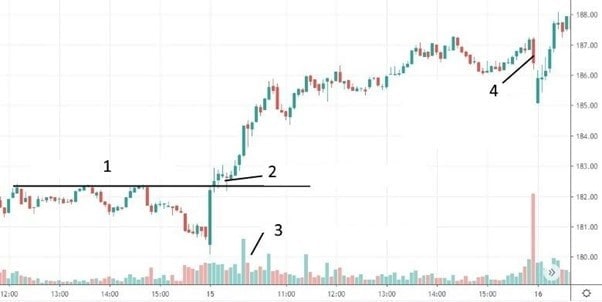
1 - Previous day resistance level
2 - Breakout soon after the market opens
3 - Volume supports the price action
4 - In this case, the price continued to make higher highs and higher lows, so there was no reason to sell until the end of the day.
Pattern Trading
Classical chart patterns are usually associated with daily and weekly charts. However, the same chart patterns occur on short-term charts, and they can be traded intraday.
Like momentum trades, they are best suited to very liquid instruments with clean charts. Day traders use chart patterns to trade indices, forex, stocks and commodity futures.
One caveat for day traders is to make sure that there is enough time left in the trading session for the price to reach its target. For this reason, it's best to trade chart patterns early in the session.
Pros
- Chart patterns allow day traders to trade in trending and range bound markets. Reversal patterns can be used when markets are range bound, and continuation patterns can be used when a trend is in place.
- Chart patterns have specific targets, which takes a lot of the guesswork out of trading them.
Cons:
- Chart patterns are less reliable on short-term charts.
- Sometimes a chart pattern's target will only be reached the next day.
Pattern trade example:
In this example, we have a pennant pattern set up early in the trading session on the 5-minuteAmazon chart. Pennants are continuation patterns, and a trade is entered when the price breaks out of the pattern in the direction of the preceding trend. For a bullish pennant, a stop loss can be placed below the lowest point of the pattern, and the target is equal to the height of the movement leading up to the pennant.
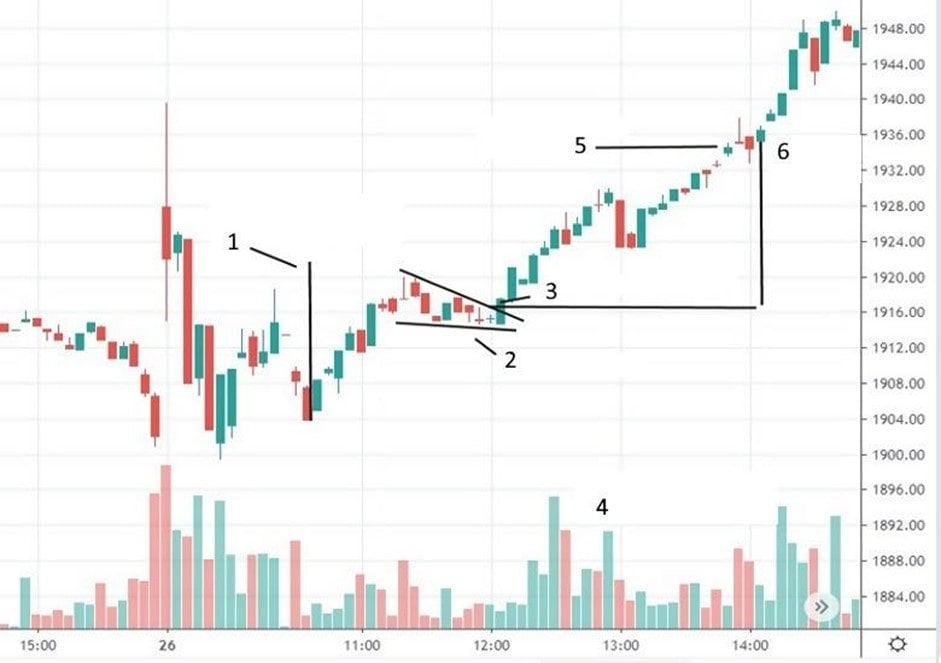
1 - Flagpole = trend leading into pattern
2 - Pennant pattern
3 - Enter as trend resumes
4 - Strong volume supports breakout
5 - Target = height of the flagpole
6 - Exit at the price target
News Trading
Most equity news is released before the market opens or after it closes. That means that for stocks, news trading is better suited to swing and position trading. Forex instruments and indices can, however, be traded around economic news releases.
Often, the best way to trade a news release is to wait for the initial reaction from the price and then wait for the direction of that movement to be confirmed or rejected.
Pros
- News events can create possibilities when other traders are trapped on the wrong side of a trade.
- Profits can be made very quickly, which means capital is at risk for a short period of time.
Cons
- News trading requires more experience, and it's more difficult to create specific rules for a news trading strategy.
- There are fewer opportunities to profit from news events than other strategies.
Example
In this example, the US non-farm payrolls came out well below what the market expected. The chart below is a 15-minute chart of the GBP/USD pair when the news came out that the GBP initially strengthened after the assumption that a low number was bad for the pound. The market then reversed and broke the minor low, providing an opportunity to open a short GBP position. A trader could have used a trailing stop or waited for the price to make a higher high before exiting.
Some of the best new entry options are created when the market's initial reaction is wrong. In this case, all those that bought the pound had to sell, adding to the downward momentum.
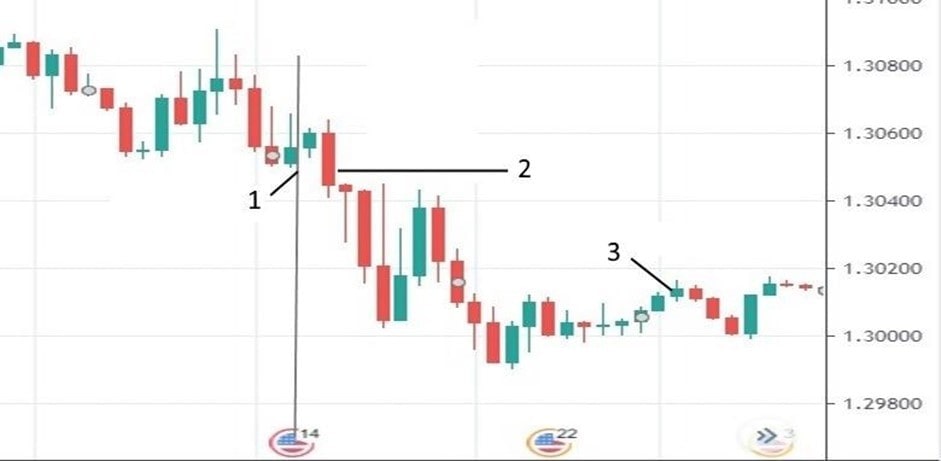
1 - News released
2 - Enter here
3 - Exit on higher high
Mean Reversion
Most of the time, prices oscillate around a mean price. Traders can take advantage of this by buying or selling at extremes and waiting for the price to return to the middle of a trading range or to a moving average.
During periods of consolidation, mean reversion trades are often the only trades that work. However, they can also be used during well-defined trend channels.
You can use support and resistance levels, trend lines, Bollinger Bands or oscillators to identify extremes, and you can use a moving average to define the middle of a trading range.
Pros
- Mean reversion trades are great for range-bound markets but can also be used in a trending market.
- Once the market turns, the price usually moves back to the mean quickly.
Cons
- If volatility increases, mean reversion trades often begin to fail.
- Mean reversion trading is more difficult for newbie traders than momentum trading.
Example
The 60-minute Starbucks chart below includes a Bollinger Band. There were several opportunities to profit from moves back to the mean after the upper band was tagged. Although the price didn't often fall below the moving average, when it did, it always tagged the lower band before moving back to the moving average.
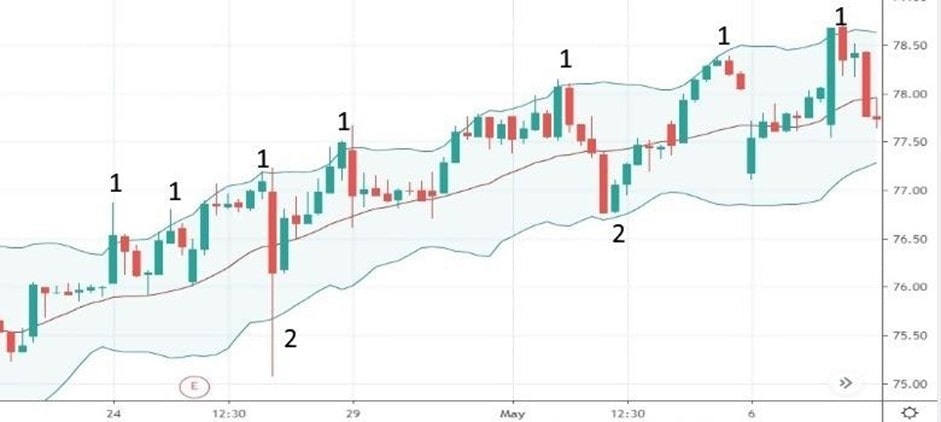
1 - Short opportunities
2 - Long opportunities
Conclusion
Day trading offers a rewarding opportunity to become financially independent while challenging to perform. There are several ways to day trade, and provided you have the time, you should be able to find a style that's right for you.
If you're keen to get started with day trading, Libertex is the platform for you. Libertex is a broker and trading platform which offers CFDs stocks, commodities, indices, ETFs and cryptocurrencies with leverage. But please note that trading CFDs with leverage can be risky and can lead to losing all of your invested capital. You can learn more about day trading without risking any capital by opening a demo account with Libertex today.
Disclaimer: The information in this article is not intended to be and does not constitute investment advice or any other form of advice or recommendation of any sort offered or endorsed by Libertex. Past performance does not guarantee future results.
Why trade with Libertex?
- Get access to a free demo account free of charge.
- Enjoy technical support from an operator 5 days a week, from 9 a.m. to 9 p.m. (Central European Standard Time).
- Use a multiplier of up to 1:30 (for retail clients).
- Operate on a platform for any device: Libertex and MetaTrader.